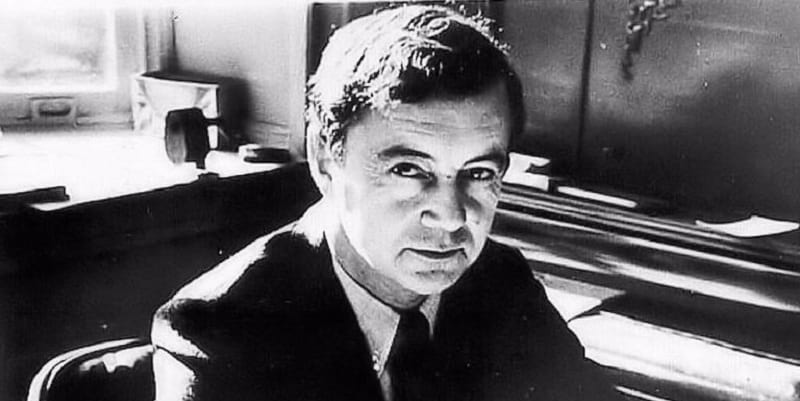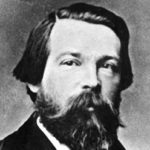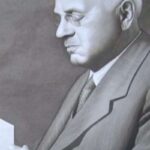Erving Goffman biografie en quotes

Erving Goffman (1922-1982) was een Canadees-Amerikaanse socioloog, schrijver en sociaal psycholoog. Hij staat bekend om zijn sterke invloeden in de Amerikaanse sociologie van de twintigste eeuw. In ‘The Presentation of Self in Everyday Life’ (1959) schetste hij het dramaturgische perspectief dat hij eveneens zou gebruiken in volgende studies zoals Asylums (1961).
Erving Goffman deed voornamelijk onderzoek naar persoonlijke communicatie en rituelen van sociale interactie. In ‘Forms of Talk’ richtte hij zich voornamelijk op de manier waarop mensen in het communicatieve proces de sociale realiteit definiëren. Dit wordt ook wel interactisme genoemd.
Zijn ontwikkeling werd beïnvloed door grootheden in de sociologische kringen, waarvan Everett Hughes wordt beschouwd als zijnde de degene die de visie van Erving het meest heeft beïnvloed.
Biografie Erving Goffman
Het vroege leven van Erving Goffman
Erving Goffman werd geboren op 11 juni 1922 in Alberta, Canada. Zijn ouders waren Max en Anne Goffman, Oekraïense joden die vlak voor zijn geboorde naar Canada waren geëmigreerd. Rond de tijd dat Goffman naar de middelbare school zou gaan verhuisden zijn ouders naar Manitoba.
Goffman ging naar het St. John’s Technical High School in Winnipeg, en begon later in 1939 zijn studie scheikunde aan de Universiteit van Manitoba. Na een aantal jaar besloot Goffman over te stappen naar sociologie, en voltooide in 1945 zijn BA.
Na het succesvol voltooien zijn eerste universitaire opleiding schreef Erving Goffman zich in voor een graduate school, en voltooide een doctoraat in de sociologie in 1953. Opgeleid in de traditie van de Chicago School of Sociology, deed etnografisch onderzoek en studeerde met name de symbolische interactietheorie.
Later deed hij uit de boeken dat onder anderen Sigmund Freud, Talcott Parsons, Georg Simmel en Herbert Blumer grote invloeden hadden op zijn werk.
Voor zijn proefschrift deed hij een studie naar alledaagse sociale interactie en rituelen op Unset. Unset is een eiland tussen de Shetland-eilanden aan de kust van Schotland.
In 1952 trouwde Erving Goffman met Angelica Choate. Samen kregen zij een zoon, Thomas. Angelica pleegde in 1964 zelfmoord, aangewakkerd door een psychische aandoening.
Carrière Erving Goffman
Nadat hij zijn doctoraat voltooide, en na zijn huwelijk, accepteerde Goffman een baan bij het National Institute for Mental Health in Bethesda. Hier voerde hij participerend observatieonderzoek uit voor wat uiteindelijk de basis zou worden voor zijn tweede boek: ‘Asylums: Essays on the Social Situation of Mental Patients and Other Inmates’. Dit boek werd gepubliceerd in 1961. In dit boek beschreef hij hoe het proces van institutionalisering mensen socialiseert in de rol van een goede patiënt.
Het eerste boek van Goffman, ‘The Presentation of Self in Everyday Life’, is misschien wel zijn beroemdste werk. Op basis van het voorheen genoemde onderzoek in Schotland heeft Goffman in dit boek zijn dramaturgische benadering uiteengezet voor het bestuderen van de details van alledaagse persoonlijke interactie en impressiemanagement.
Om het belang van menselijke en sociale interactie uit te beelden, gebruikte hij beeldtaal uit het theater. Alle acties, zo betoogde hij, zijn sociale prestaties die een bepaald doel hebben, namelijk, de gewenste indrukken van iemand aan anderen te geven en te behouden.
Hij legt verder uit dat sociale interacties eigenlijk acteurs bevatten, mensen, op een podium die een voorstelling spelen voor een publiek. De enige keer dat individuen zichzelf kunnen zijn, en hun rol dus kwijtraken, is wanneer er geen publiek aanwezig is. Dit gaat op voor iedereen die deel uitmaakt van een samenleving.
Vanaf 1958 bekleedde Erving Goffman een facultaire functie bij de afdeling sociologie aan de universiteit van California-Berkeley. In 1962 werd hij daar gepromoveerd tot hoogleraar. In 1968 werd hij benoemd tot Benjamin Franklin-leerstoel Sociologie en Antropologie aan de Universiteit van Pennsylvania.
Goffman’s bevindingen over zijn laatste grote onderzoek werd gepubliceerd in ‘Goffman’s Frame Analysis: An Essay on the Organization of Experience’. Dit boek werd in 1974 gepubliceerd. Frame-analyse is de studie van de organisatie van bepaalde sociale ervaringen.
Goffman schreef met zijn boek over hoe conceptuele frames de perceptie van een individu kunnen structureren. Om dit concept te illustreren gebruikte Erving Goffman het concept van een fotolijst. Het frame, zo zei hij, vertegenwoordigd structuur en wordt gebruikt om de context van een individu bij elkaar te houden, weergegeven door een foto.
Toen Goffman onderzoek deed naar de symbolische interactietheorie, begon hij de mannen en vrouwen van de wereld te zien als een onderdeel van een drama. In dat drama spelen de mannen en vrouwen een specifieke rol.
Persoonlijke leven en laatste jaren
Na zijn eerste huwelijk, waaruit hij een zoon overhield, hertrouwde Erving Goffman in 1981 met Gillian Sankoff. Gillian was een socio-linguist. Samen kregen zij een dochter, Alice. Zij werd geboren in 1982.
In datzelfde jaar stierf Goffman aan maagkanker. Zijn dochter Alice Goffman werd een op zichzelf staande en opmerkelijke socioloog.
Kritiek
Hoewel Erving Goffman veel volgers had in de sociologie, kreeg zijn werk ook veel kritiek op sommige punten. Hij brak bijna alle regels van de conventionele methodologie. Zijn bronnen waren vaak onduidelijk, zijn veldwerk leek minimaal en hij was meer geïnteresseerd in romans en biografieën. Zijn stijl was niet de stijl van een gebruikelijk wetenschappelijk rapport, en hij bleek erg onsystematisch te werk te gaan.
Daarnaast wordt hij er voortdurend van beschuldigd de bredere macro-sociale aspecten van zijn studie te negeren, zoals sociale structuur, klassen en economieën. Hierover zei hij dat dit niet slechts zijn zorgen waren, maar dat deze belangrijker waren dan zorgen. Anderen beschuldigden hem van conservatisme, omdat hij vaak de nadruk legde op het belang van orde en ritueel, geslacht en het behoud van aspecten zoals de status quo.
Erving Goffman quotes
- “Approved attributes and their relation to face make every man his own jailer; this is a fundamental social constraint even though each man may like his cell.”
- “And to the degree that the individual maintains a show before others that he himself does not believe, he can come to experience a special kind of alienation from self and a special kind of wariness of others.”
- “We are all just actors trying to control and manage our public image, we act based on how others might see us.”
- “Perhaps the individual is so viable a god because he can actually understand the ceremonial significance of the way he is treated, and quite on his own can respond dramatically to what is proffered him. In contacts between such deities there is no need for middlemen; each of these gods is able to serve as his own priest.”
- “Gender, not religion, is the opiate of the masses.”
- “In reviewing his own moral career, the stigmatized individual may single out and retrospectively elaborate experiences which serve for him to account for his coming to the beliefs and practices that he now has regarding his own kind and normals.”
- “The act of staring is a thing which one does not ordinarily do to another human being; it seems to put the object stared at in a class apart. One does not talk to a monkey in a zoo, or to a freak in a sideshow— one only stares.”
- “the model of “social order.” Briefly, a social order may be defined as the consequence of any set of moral norms that regulates the way in which persons pursue objectives.”
- “Choose your self-presentations carefully, for what starts out as a mask may become your face. ”
- “The self… is not an organic thing that has a specific location, whose fundamental fate is to be born, to mature, to die; it is a dramatic effect arising diffusely from a scene that is presented. ”
- “The normal and the stigmatized are not persons, but perspectives. ”
- “Society is organized on the principle that any individual who possesses certain social characteristics has a moral right to expect that others will value and treat him in an appropriate way. ”
- “All the world is not, of course, a stage, but the crucial ways in which it isn’t are not easy to specify. ”
- “Society is an insane asylum ran by the inmates. ”
- “Stigma is a process by which the reaction of others spoils normal identity. ”
- “And to the degree that the individual maintains a show before others that he himself does not believe, he can come to experience a special kind of alienation from self and a special kind of wariness of others. “
- “Approved attributes and their relation to face make every man his own jailer; this is a fundamental social constraint even though each man may like his cell. “
- “The world, in truth, is a wedding. “
- “Man is not like other animals in the ways that are really significant: Animals have instincts, we have taxes. “
- “When persons are present to one another they can function not merely as physical instruments but also as communicative ones. This possibility, no less than the physical one, is fateful for everyone concerned and in every society appears to come under strict normative regulation, giving rise to a kind of communication traffic order. “
Publicaties en boeken van Erving Goffman et al.
- 2009. Relations in public. Transaction Publishers.
- 2009, 2003. Stigma. Praha: Sociologické nakladatelství (SLON).
- 2008. Behavior in public places. Simon and Schuster.
- 2006. Where the action is. The sociology of risk and gambling reader, 225-254.
- 2005. Interaction ritual: Essays in face to face behavior. AldineTransaction.
- 2002. The presentation of self in everyday life. 1959. Garden City, NY, 259.
- 2001, 1989. On fieldwork. Journal of contemporary ethnography, 18(2), 123-132.
- 1983. Felicity’s condition. American journal of sociology, 89(1), 1-53.
- 1983. The interaction order: American Sociological Association, 1982 presidential address. American sociological review, 48(1), 1-17.
- 1981. A reply to Denzin and Keller.
- 1981. Forms of talk. University of Pennsylvania Press.
- 1979. Footing. Semiotica, 25(1-2), 1-30.
- 1979. Gender advertisements. Macmillan International Higher Education.
- 1978. Response cries. Language, 787-815.
- 1977. The arrangement between the sexes. Theory and society, 4(3), 301-331.
- 1976. Gender display. In Gender advertisements (pp. 1-9). Palgrave, London.
- 1975. Role-distance. Life as Theater: A dramaturgical sourcebook, 123-132.
- 1970. Strategic interaction (Vol. 1). University of Pennsylvania Press.
- 1969. The insanity of place. Psychiatry, 32(4), 357-388.
- 1968. Asylums: Essays on the social situation of mental patients and other inmates. AldineTransaction.
- 1967. On face-work. Interaction ritual, 5-45.
- 1964. The neglected situation. American anthropologist, 66(6), 133-136.
- 1961. Encounters: Two studies in the sociology of interaction. Ravenio Books.
- 1959. The moral career of the mental patient. Psychiatry, 22(2), 123-142.
- 1958. Characteristics of total institutions. In Symposium on preventive and social psychiatry (pp. 43-84). US Government Printing Office.
- 1957. Alienation from interaction. Human relations, 10(1), 47-60.
- 1956. Embarrassment and social organization. American Journal of sociology, 62(3), 264-271.
- 1956. The nature of deference and demeanor. American Anthropologist, 58(3), 473-502.
- 1955. On face-work: An analysis of ritual elements in social interaction. Psychiatry, 18(3), 213-231.
- 1952. On cooling the mark out: Some aspects of adaptation to failure. Psychiatry, 15(4), 451-463.
- 1951. Symbols of class status. The British journal of sociology, 2(4), 294-304.
Citatie voor dit artikel:
Janse, B. (2020). Erving Goffman. Retrieved [insert date] from Toolshero: https://www.toolshero.nl/bekende-auteurs/erving-goffman/
Oorspronkelijke publicatiedatum: 07/07/2020| Laatste update: 19/04/2023
Wilt u linken naar dit artikel, dat kan!
<a href=”https://www.toolshero.nl/bekende-auteurs/erving-goffman/”>Toolshero: Erving Goffman</a>












